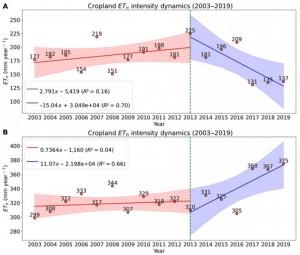New model tracks agricultural impact on lake ecosystems
FAYETTEVILLE, GA, UNITED STATES, May 23, 2025 /EINPresswire.com/ -- A recent study has unveiled an innovative data-driven model that disentangles human-induced and natural water consumption in croplands, shedding new light on the sustainability of arid lake ecosystems.
Drylands, covering 42% of the Earth's land surface and supporting 38% of the global population, are at the forefront of the battle for scarce water resources. The relentless expansion of agriculture has placed immense pressure on these fragile ecosystems, with many tail-end lakes shrinking or vanishing entirely due to excessive irrigation. The urgency to develop advanced monitoring and management strategies has never been greater, as sustainable water use becomes a key determinant of food security and ecological balance in arid regions.
Published in Journal of Remote Sensing on 1 Apr, 2025, a new study (DOI: 10.34133/remotesensing.0496) by researchers from the Chinese Academy of Sciences and international collaborators presents a cutting-edge model capable of isolating natural and human-driven water consumption in croplands. The study focuses on the Ebinur Lake Basin in China, an arid region where agricultural growth has increasingly strained water resources. By leveraging remote sensing and machine learning, the model provides unprecedented clarity on water usage patterns, offering actionable insights for sustainable resource management.
At the heart of this research is a sophisticated approach to distinguishing cropland evapotranspiration (ET) into its natural (ETn) and human-induced (ETh) components. The model demonstrated remarkable accuracy, with R² values between 0.88 and 0.96, revealing that by 2019, human activities were responsible for 77% of cropland water consumption. A striking finding was that restoring Ebinur Lake to its optimal surface area of 800 km² would require an additional 0.29 km³ of water annually—a stark indicator of the toll agricultural expansion has taken on regional water reserves.
Utilizing Sentinel-2 satellite imagery, deep learning, and machine learning algorithms, the researchers monitored cropland and lake dynamics from 2003 to 2019. A random forest regressor was trained to model the relationship between environmental factors and natural ET, achieving high predictive accuracy. The study found that cropland in the Ebinur Lake Basin expanded by 50.65% over the study period, driving a 61% surge in total water consumption. Notably, ETh saw a sharp increase after 2013, correlating with a rapid rise in irrigated farmland. These findings were rigorously validated using water level data from the DAHITI database and surface water measurements from the Global Surface Water Dataset (GSWD).
“Our model provides a transformative tool for understanding the intricate interactions between human activities and natural processes in agricultural water consumption, and its impact on water storage of the end-tail lakes in dryland” said Dr. Hongwei Zeng, the study’s lead author. “This is a crucial step toward achieving sustainable water management in arid regions, where the delicate balance between agriculture and ecosystem preservation is becoming increasingly precarious.”
By combining high-resolution satellite data with advanced machine learning techniques, the study offers a new paradigm for water resource management. The model’s ability to quantify and distinguish between natural and human-driven water use can inform policies aimed at curbing excessive irrigation while ensuring food security. Looking ahead, potential applications include real-time water monitoring, optimized irrigation strategies, and proactive conservation efforts to prevent lake desiccation in water-stressed regions such as Central Asia and beyond.
This research marks a pivotal step toward sustainable water management in arid environments, offering a data-driven pathway to tackling one of the most pressing environmental challenges of our time.
References
DOI
10.34133/remotesensing.0496
Original Source URL
https://spj.science.org/doi/10.34133/remotesensing.0496
Funding Information
This work was supported by the National Natural Science Foundations of China (42071271, 41991232 and 42471319), and the Youth Innovation Promotion Association of Chinese Academy of Sciences (2022125).
Lucy Wang
BioDesign Research
email us here
Legal Disclaimer:
EIN Presswire provides this news content "as is" without warranty of any kind. We do not accept any responsibility or liability for the accuracy, content, images, videos, licenses, completeness, legality, or reliability of the information contained in this article. If you have any complaints or copyright issues related to this article, kindly contact the author above.
Comprehensive Report on the Plant-Based Protein Market: Opportunities and Challenges
Pea Protein Ingredients Industry Report: Competitive Landscape and Future Prospects
Food Preservatives Market Trends and Analysis by Application, Vertical, Region, and Segment Forecast to 2029
Więcej ważnych informacji
 Jedynka Newserii
Jedynka Newserii

 Jedynka Newserii
Jedynka Newserii

Polityka

D. Joński: Nie wiemy, co zrobi Rosja za dwa–trzy lata. Według duńskiego wywiadu może zaatakować kraje nadbałtyckie i musimy być na to gotowi
Zdecydowana większość krajów unijnych wskazuje na potrzebę wzmocnienia zdolności obronnych Europy w obliczu coraz bardziej złożonego geopolitycznego tła. Wywiady zachodnich państw wskazują, że Rosja może rozpocząć konfrontację z NATO jeszcze przed 2030 rokiem. Biała księga w sprawie obronności europejskiej „Gotowość 2030” zakłada m.in. ochronę granic lądowych, powietrznych i morskich UE, a sztandarowym projektem ma być Tarcza Wschód. – W budzeniu Europy duże zasługi ma polska prezydencja – ocenia europoseł Dariusz Joński.
Transport
Duże magazyny energii przyspieszą rozwój transportu niskoemisyjnego w Europie. Przyszłością może być wodór służący jako paliwo i nośnik energii

Zmiany w europejskim transporcie przyspieszają. Trendem jest elektromobilność, zwłaszcza w ramach logistyki „ostatniej mili”. Jednocześnie jednak udział samochodów w pełni elektrycznych w polskich firmach spadł z 18 do 12 proc., co wpisuje się w szerszy europejski trend spowolnienia elektromobilności. Główne bariery to ograniczona liczba publicznych stacji ładowania, wysoka cena pojazdów i brak dostępu do odpowiedniej infrastruktury. – Potrzebne są odpowiednio duże magazyny taniej energii. Przyszłością przede wszystkim jest wodór – ocenia Andrzej Gemra z Renault Group.
Infrastruktura
W Polsce w obiektach zabytkowych wciąż brakuje nowoczesnych rozwiązań przeciwpożarowych. Potrzebna jest większa elastyczność w stosowaniu przepisów

Pogodzenie interesów konserwatorów, projektantów, inwestorów, rzeczoznawców i służby ochrony pożarowej stanowi jedno z największych wyzwań w zakresie ochrony przeciwpożarowej obiektów konserwatorskich. Pożary zabytków takich jak m.in. katedra Notre-Dame w Paryżu przyczyniają się do wprowadzania nowatorskich rozwiązań technicznych w zakresie ochrony przeciwpożarowej. W Polsce obowiązuje już konieczność instalacji systemów detekcji. Inwestorzy często jednak rezygnują z realizacji projektów dotyczących obiektów zabytkowych z uwagi na zmieniające się i coraz bardziej restrykcyjne przepisy czy też względy ekonomiczne.
Partner serwisu
Szkolenia

Akademia Newserii
Akademia Newserii to projekt, w ramach którego najlepsi polscy dziennikarze biznesowi, giełdowi oraz lifestylowi, a także szkoleniowcy z wieloletnim doświadczeniem dzielą się swoją wiedzą nt. pracy z mediami.




![Nestlé w Polsce podsumowuje wpływ na krajową gospodarkę. Firma wygenerowała 0,6 proc. polskiego PKB [DEPESZA]](https://www.newseria.pl/files/1097841585/fabryka-nesquik_1,w_85,r_png,_small.png)




.gif)

 |
| |
| |
|